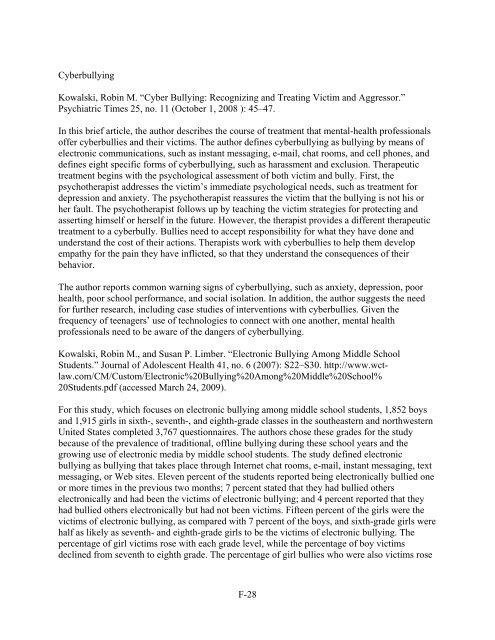The National Strategy for Child Exploitation Prevention and Interdiction
The National Strategy for Child Exploitation Prevention and Interdiction
The National Strategy for Child Exploitation Prevention and Interdiction
Create successful ePaper yourself
Turn your PDF publications into a flip-book with our unique Google optimized e-Paper software.
CyberbullyingKowalski, Robin M. “Cyber Bullying: Recognizing <strong>and</strong> Treating Victim <strong>and</strong> Aggressor.”Psychiatric Times 25, no. 11 (October 1, 2008 ): 45–47.In this brief article, the author describes the course of treatment that mental-health professionalsoffer cyberbullies <strong>and</strong> their victims. <strong>The</strong> author defines cyberbullying as bullying by means ofelectronic communications, such as instant messaging, e-mail, chat rooms, <strong>and</strong> cell phones, <strong>and</strong>defines eight specific <strong>for</strong>ms of cyberbullying, such as harassment <strong>and</strong> exclusion. <strong>The</strong>rapeutictreatment begins with the psychological assessment of both victim <strong>and</strong> bully. First, thepsychotherapist addresses the victim’s immediate psychological needs, such as treatment <strong>for</strong>depression <strong>and</strong> anxiety. <strong>The</strong> psychotherapist reassures the victim that the bullying is not his orher fault. <strong>The</strong> psychotherapist follows up by teaching the victim strategies <strong>for</strong> protecting <strong>and</strong>asserting himself or herself in the future. However, the therapist provides a different therapeutictreatment to a cyberbully. Bullies need to accept responsibility <strong>for</strong> what they have done <strong>and</strong>underst<strong>and</strong> the cost of their actions. <strong>The</strong>rapists work with cyberbullies to help them developempathy <strong>for</strong> the pain they have inflicted, so that they underst<strong>and</strong> the consequences of theirbehavior.<strong>The</strong> author reports common warning signs of cyberbullying, such as anxiety, depression, poorhealth, poor school per<strong>for</strong>mance, <strong>and</strong> social isolation. In addition, the author suggests the need<strong>for</strong> further research, including case studies of interventions with cyberbullies. Given thefrequency of teenagers’ use of technologies to connect with one another, mental healthprofessionals need to be aware of the dangers of cyberbullying.Kowalski, Robin M., <strong>and</strong> Susan P. Limber. “Electronic Bullying Among Middle SchoolStudents.” Journal of Adolescent Health 41, no. 6 (2007): S22–S30. http://www.wctlaw.com/CM/Custom/Electronic%20Bullying%20Among%20Middle%20School%20Students.pdf (accessed March 24, 2009).For this study, which focuses on electronic bullying among middle school students, 1,852 boys<strong>and</strong> 1,915 girls in sixth-, seventh-, <strong>and</strong> eighth-grade classes in the southeastern <strong>and</strong> northwesternUnited States completed 3,767 questionnaires. <strong>The</strong> authors chose these grades <strong>for</strong> the studybecause of the prevalence of traditional, offline bullying during these school years <strong>and</strong> thegrowing use of electronic media by middle school students. <strong>The</strong> study defined electronicbullying as bullying that takes place through Internet chat rooms, e-mail, instant messaging, textmessaging, or Web sites. Eleven percent of the students reported being electronically bullied oneor more times in the previous two months; 7 percent stated that they had bullied otherselectronically <strong>and</strong> had been the victims of electronic bullying; <strong>and</strong> 4 percent reported that theyhad bullied others electronically but had not been victims. Fifteen percent of the girls were thevictims of electronic bullying, as compared with 7 percent of the boys, <strong>and</strong> sixth-grade girls werehalf as likely as seventh- <strong>and</strong> eighth-grade girls to be the victims of electronic bullying. <strong>The</strong>percentage of girl victims rose with each grade level, while the percentage of boy victimsdeclined from seventh to eighth grade. <strong>The</strong> percentage of girl bullies who were also victims roseF-28
















